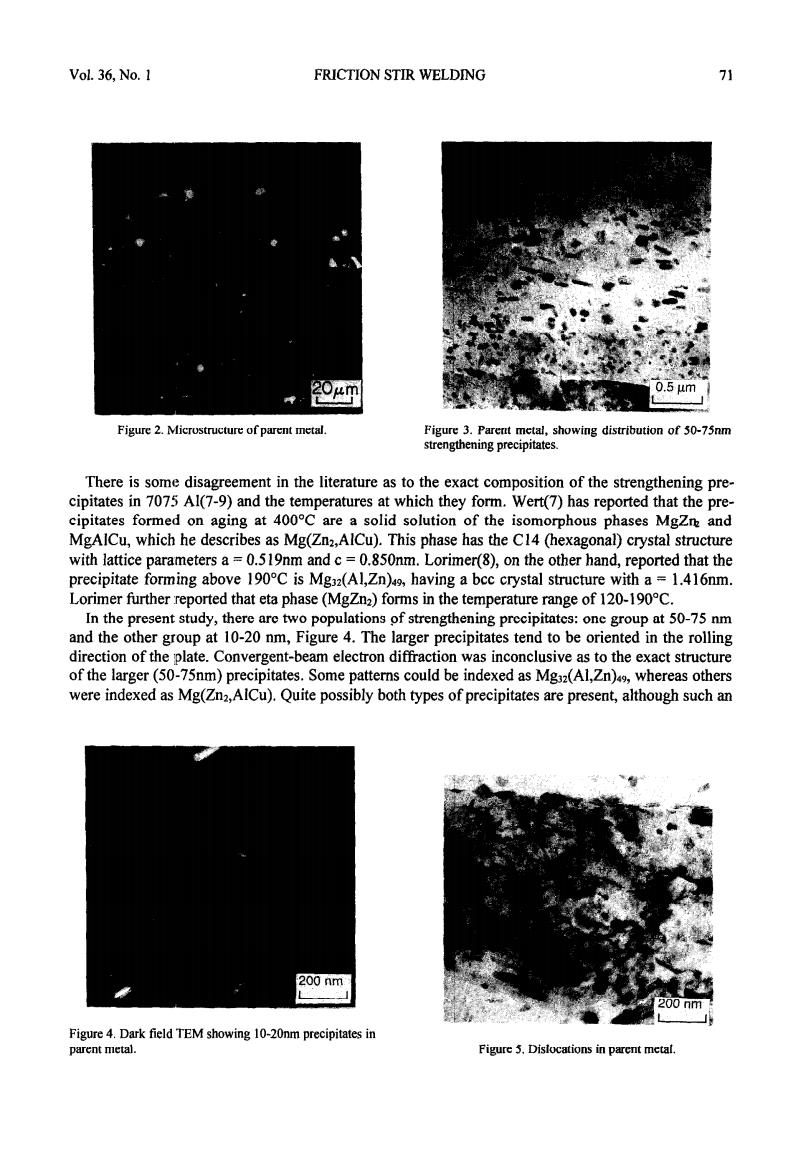正在加载图片...

Vol.36,No.I FRICTION STIR WELDING 71 0.5μm Figure 2.Microstructure of parent metal Figure 3.Parent metal,showing distribution of 50-75nm strengthening precipitates. There is some disagreement in the literature as to the exact composition of the strengthening pre- cipitates in 7075 Al(7-9)and the temperatures at which they form.Wert(7)has reported that the pre- cipitates formed on aging at 400C are a solid solution of the isomorphous phases MgZn and MgAICu,which he describes as Mg(Zn2,AlCu).This phase has the C14 (hexagonal)crystal structure with lattice parameters a=0.519nm and c=0.850nm.Lorimer(8),on the other hand,reported that the precipitate forming above 190C is Mgz(Al,Zn)49,having a bcc crystal structure with a=1.416nm. Lorimer further reported that eta phase(MgZn2)forms in the temperature range of 120-190C. In the present study,there are two populations of strengthening precipitates:one group at 50-75 nm and the other group at 10-20 nm,Figure 4.The larger precipitates tend to be oriented in the rolling direction of the plate.Convergent-beam electron diffraction was inconclusive as to the exact structure of the larger(50-75nm)precipitates.Some patterns could be indexed as Mgs2(Al,Zn)49,whereas others were indexed as Mg(Zn2,AlCu).Quite possibly both types of precipitates are present,although such an 200nm 200nm Figure 4.Dark field TEM showing 10-20nm precipitates in parent metal. Figure 5.Dislocations in parent metalVol. 36, No. I FRICTION STIR WELDING 71 Figure 2. hGcrostructure of parent metal. Figure 3. Parent metal, showing distribution of 50-75nm strengthening precipitates. There is some disagreement in the literature as to the exact composition of the strengthening precipitates in 7075 Al(7-9) and the temperatures at which they form. Wert(7) has reported that the precipitates formed on aging at 400°C are a solid solution of the isomorphous phases MgZrb and MgAlCu, which he describes as Mg(Znz,AICu). This phase has the Cl4 (hexagonal) crystal structure with lattice parameters a = 0.5 19nm and c = 0.85Onm. Lorimer(8), on the other hand, reported that the precipitate forming above 190°C is MgS2(A1,Zn&, having a bee crystal structure with a = 1.4 16nm. Lorimer further :reported that eta phase (MgZnz) forms in the temperature range of 120-190°C. In the present study, there are two populations of strengthening precipitates: one group at 50-75 nm and the other group at lo-20 nm, Figure 4. The larger precipitates tend to be oriented in the rolling direction of the Iplate. Convergent-beam electron diffraction was inconclusive as to the exact structure of the larger (50-75nm) precipitates. Some patterns could be indexed as Mgjz(Al,Zn)49, whereas others were indexed as Mg(Zns,AlCu). Quite possibly both types of precipitates are present, although such an Figure 4. Dark field TEM showing lo-20nm precipitates in parent metal. Figure 5. Dislocations in parent metal